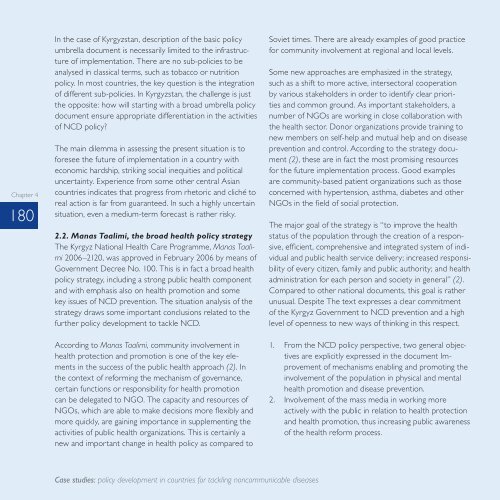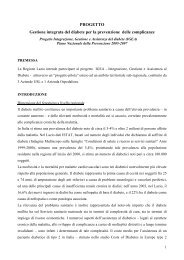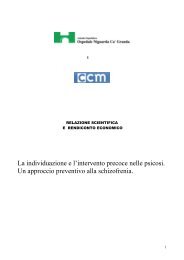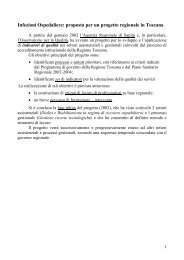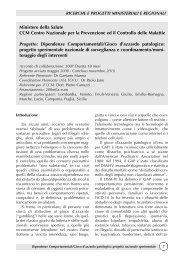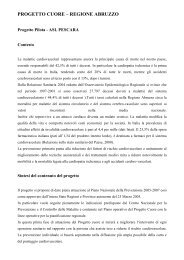Gaining health : analysis of policy development in European ...
Gaining health : analysis of policy development in European ...
Gaining health : analysis of policy development in European ...
You also want an ePaper? Increase the reach of your titles
YUMPU automatically turns print PDFs into web optimized ePapers that Google loves.
Chapter 4<br />
180<br />
In the case <strong>of</strong> Kyrgyzstan, description <strong>of</strong> the basic <strong>policy</strong><br />
umbrella document is necessarily limited to the <strong>in</strong>frastructure<br />
<strong>of</strong> implementation. There are no sub-policies to be<br />
analysed <strong>in</strong> classical terms, such as tobacco or nutrition<br />
<strong>policy</strong>. In most countries, the key question is the <strong>in</strong>tegration<br />
<strong>of</strong> different sub-policies. In Kyrgyzstan, the challenge is just<br />
the opposite: how will start<strong>in</strong>g with a broad umbrella <strong>policy</strong><br />
document ensure appropriate differentiation <strong>in</strong> the activities<br />
<strong>of</strong> NCD <strong>policy</strong>?<br />
The ma<strong>in</strong> dilemma <strong>in</strong> assess<strong>in</strong>g the present situation is to<br />
foresee the future <strong>of</strong> implementation <strong>in</strong> a country with<br />
economic hardship, strik<strong>in</strong>g social <strong>in</strong>equities and political<br />
uncerta<strong>in</strong>ty. Experience from some other central Asian<br />
countries <strong>in</strong>dicates that progress from rhetoric and cliché to<br />
real action is far from guaranteed. In such a highly uncerta<strong>in</strong><br />
situation, even a medium-term forecast is rather risky.<br />
2.2. Manas Taalimi, the broad <strong>health</strong> <strong>policy</strong> strategy<br />
The Kyrgyz National Health Care Programme, Manas Taalimi<br />
2006–2120, was approved <strong>in</strong> February 2006 by means <strong>of</strong><br />
Government Decree No. 100. This is <strong>in</strong> fact a broad <strong>health</strong><br />
<strong>policy</strong> strategy, <strong>in</strong>clud<strong>in</strong>g a strong public <strong>health</strong> component<br />
and with emphasis also on <strong>health</strong> promotion and some<br />
key issues <strong>of</strong> NCD prevention. The situation <strong>analysis</strong> <strong>of</strong> the<br />
strategy draws some important conclusions related to the<br />
further <strong>policy</strong> <strong>development</strong> to tackle NCD.<br />
Accord<strong>in</strong>g to Manas Taalimi, community <strong>in</strong>volvement <strong>in</strong><br />
<strong>health</strong> protection and promotion is one <strong>of</strong> the key elements<br />
<strong>in</strong> the success <strong>of</strong> the public <strong>health</strong> approach (2). In<br />
the context <strong>of</strong> reform<strong>in</strong>g the mechanism <strong>of</strong> governance,<br />
certa<strong>in</strong> functions or responsibility for <strong>health</strong> promotion<br />
can be delegated to NGO. The capacity and resources <strong>of</strong><br />
NGOs, which are able to make decisions more flexibly and<br />
more quickly, are ga<strong>in</strong><strong>in</strong>g importance <strong>in</strong> supplement<strong>in</strong>g the<br />
activities <strong>of</strong> public <strong>health</strong> organizations. This is certa<strong>in</strong>ly a<br />
new and important change <strong>in</strong> <strong>health</strong> <strong>policy</strong> as compared to<br />
Soviet times. There are already examples <strong>of</strong> good practice<br />
for community <strong>in</strong>volvement at regional and local levels.<br />
Some new approaches are emphasized <strong>in</strong> the strategy,<br />
such as a shift to more active, <strong>in</strong>tersectoral cooperation<br />
by various stakeholders <strong>in</strong> order to identify clear priorities<br />
and common ground. As important stakeholders, a<br />
number <strong>of</strong> NGOs are work<strong>in</strong>g <strong>in</strong> close collaboration with<br />
the <strong>health</strong> sector. Donor organizations provide tra<strong>in</strong><strong>in</strong>g to<br />
new members on self-help and mutual help and on disease<br />
prevention and control. Accord<strong>in</strong>g to the strategy document<br />
(2), these are <strong>in</strong> fact the most promis<strong>in</strong>g resources<br />
for the future implementation process. Good examples<br />
are community-based patient organizations such as those<br />
concerned with hypertension, asthma, diabetes and other<br />
NGOs <strong>in</strong> the field <strong>of</strong> social protection.<br />
The major goal <strong>of</strong> the strategy is “to improve the <strong>health</strong><br />
status <strong>of</strong> the population through the creation <strong>of</strong> a responsive,<br />
efficient, comprehensive and <strong>in</strong>tegrated system <strong>of</strong> <strong>in</strong>dividual<br />
and public <strong>health</strong> service delivery; <strong>in</strong>creased responsibility<br />
<strong>of</strong> every citizen, family and public authority; and <strong>health</strong><br />
adm<strong>in</strong>istration for each person and society <strong>in</strong> general” (2).<br />
Compared to other national documents, this goal is rather<br />
unusual. Despite The text expresses a clear commitment<br />
<strong>of</strong> the Kyrgyz Government to NCD prevention and a high<br />
level <strong>of</strong> openness to new ways <strong>of</strong> th<strong>in</strong>k<strong>in</strong>g <strong>in</strong> this respect.<br />
1. From the NCD <strong>policy</strong> perspective, two general objectives<br />
are explicitly expressed <strong>in</strong> the document Improvement<br />
<strong>of</strong> mechanisms enabl<strong>in</strong>g and promot<strong>in</strong>g the<br />
<strong>in</strong>volvement <strong>of</strong> the population <strong>in</strong> physical and mental<br />
<strong>health</strong> promotion and disease prevention.<br />
2. Involvement <strong>of</strong> the mass media <strong>in</strong> work<strong>in</strong>g more<br />
actively with the public <strong>in</strong> relation to <strong>health</strong> protection<br />
and <strong>health</strong> promotion, thus <strong>in</strong>creas<strong>in</strong>g public awareness<br />
<strong>of</strong> the <strong>health</strong> reform process.<br />
Case studies: <strong>policy</strong> <strong>development</strong> <strong>in</strong> countries for tackl<strong>in</strong>g noncommunicable diseases


